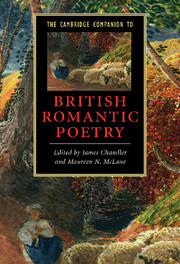Book contents
- Frontmatter
- Introduction: The companionable forms of Romantic poetry
- 1 The living pantheon of poets in 1820: pantheon or canon?
- 2 Romantic poetry and antiquity
- 3 Romantic meter and form
- 4 Romantic poetry and the standardization of English
- 5 Thinking in verse
- 6 Romantic poetry and the romantic novel
- 7 Wordsworth’s great Ode: Romanticism and the progress of poetry
- 8 Romantic poetry, sexuality, gender
- 9 Poetry, peripheries and empire
- 10 Romantic poetry and the science of nostalgia
- 11 Rethinking Romantic poetry and history: lyric resistance, lyric seduction
- 12 The medium of Romantic poetry
- 13 Romantic poets and contemporary poetry
- Index
- Series List
3 - Romantic meter and form
Published online by Cambridge University Press: 28 November 2008
- Frontmatter
- Introduction: The companionable forms of Romantic poetry
- 1 The living pantheon of poets in 1820: pantheon or canon?
- 2 Romantic poetry and antiquity
- 3 Romantic meter and form
- 4 Romantic poetry and the standardization of English
- 5 Thinking in verse
- 6 Romantic poetry and the romantic novel
- 7 Wordsworth’s great Ode: Romanticism and the progress of poetry
- 8 Romantic poetry, sexuality, gender
- 9 Poetry, peripheries and empire
- 10 Romantic poetry and the science of nostalgia
- 11 Rethinking Romantic poetry and history: lyric resistance, lyric seduction
- 12 The medium of Romantic poetry
- 13 Romantic poets and contemporary poetry
- Index
- Series List
Summary
Poetic meter is a pattern of marked linguistic features and their absence that shapes a poetic line. In English these features are most often stresses, and the pattern that emerges between marked and unmarked stresses eventually becomes the overall form that is the poem itself. Although meter is measurable, and to some degree predictable, once it has been established through a series of repetitions, the actual rhythm of a poem converges and departs from this pattern of meter, lending it texture and interest.
As early as Aristotle, such dynamic emergence, or entelechy, of form has been contrasted to structures, or finite shapes, and when we speak of poetic meters and the larger structures that are poetic forms, we must acknowledge their living dimension as well as the fixed repertoire of kinds of poems that we have inherited from literary history. Even in the two dominant forms of meter in English - accentual and accentual-syllabic verse - we find this tension between expected and emerging form. Accentual meter, which measures pure stresses alone, historically is associated with vernacular verse and song traditions, including British nursery rhymes, game chants, and ballads. Because English is isochronous, that is, it tends to have the same intervals of time between stressed syllables no matter how many unstressed syllables are between them, accentual meters follow the natural stresses of spoken language. The varying syllables of such meter, following the Anglo-Saxon line, often are characterized by four beats and a strong medial caesura. Accentual syllabic meters, however, unfold by means of an ideal pattern constituted by the relation between the number of feet, or groups of syllables, in a line and the number of stresses; in any given poem, the actual line may not supply that relation in the expected way, but the reader or listener will bear the ideal pattern in mind.
- Type
- Chapter
- Information
- The Cambridge Companion to British Romantic Poetry , pp. 53 - 75Publisher: Cambridge University PressPrint publication year: 2008
- 3
- Cited by

